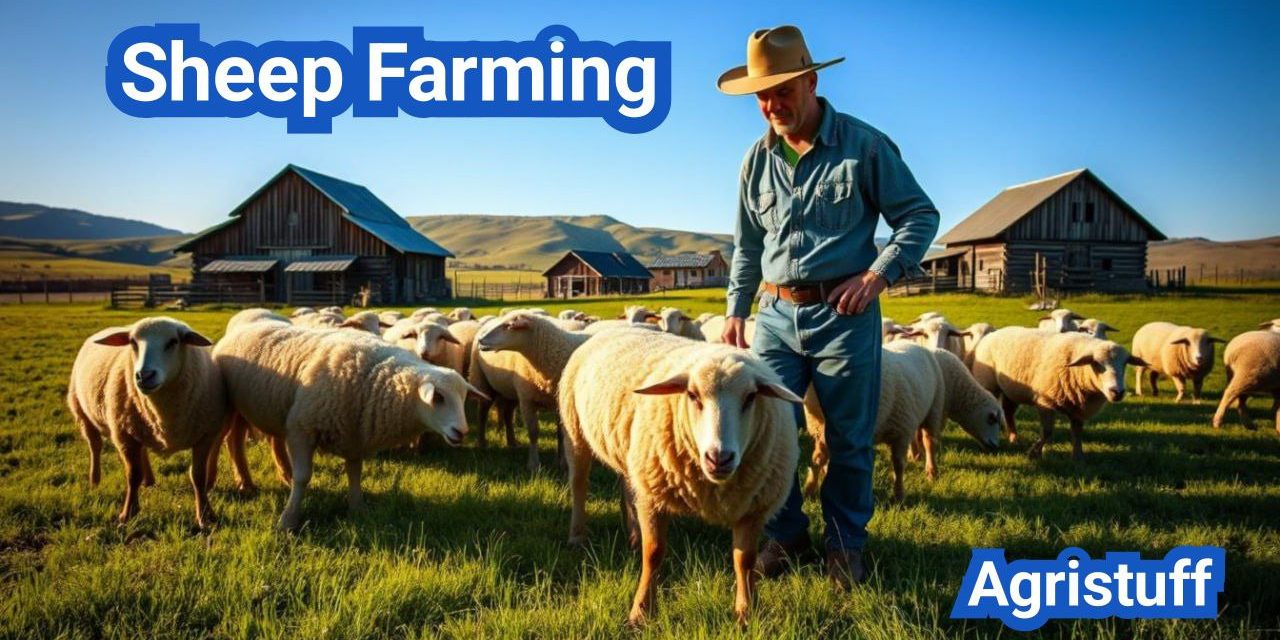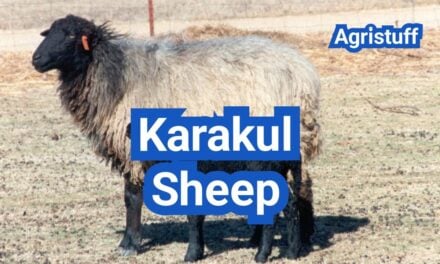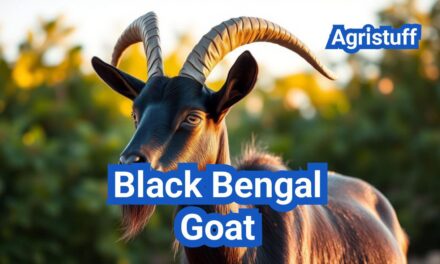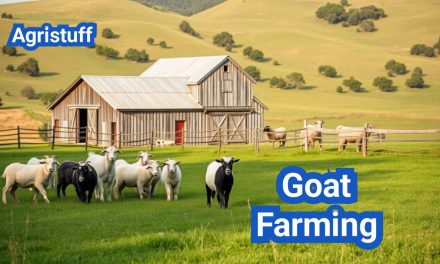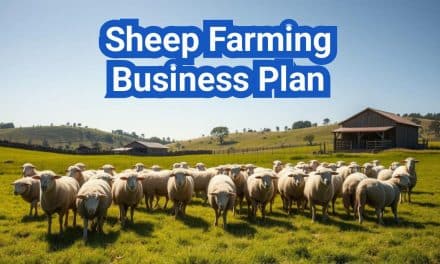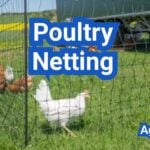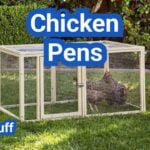For those new to sheep farming, understanding the basics is crucial. This multi-purpose animal husbandry practice involves raising sheep for their meat, milk, wool, and skins. With various breeds available, such as the Swiss Valais Blacknose Sheep and Dorper, beginners can choose the most suitable for their needs.
Sheep farming can be a rewarding venture, offering products like wool and meat. Lamb farming, a subset of this practice, focuses on raising young sheep for meat production. Beginners should consider factors like breed selection, nutrition, and health management to ensure a successful start.
Key Takeaways
- Understand the basics of sheep farming before starting.
- Choose breeds suitable for your production goals, such as wool or meat.
- Consider factors like nutrition and health management.
- Research different breeds like Swiss Valais Blacknose Sheep and Dorper.
- Plan your venture according to your resources and market demand.
Getting Started with Sheep Farming
Embarking on a sheep farming journey can be a rewarding venture for beginners. Sheep are relatively easy to manage and can thrive on pasture with minimal infrastructure, making them an attractive option for those new to farming.
Why Choose Sheep Farming
Sheep farming offers several benefits, including the potential for diversified income streams through the sale of wool, meat, and breeding stock. Additionally, sheep can be used for land management purposes, such as maintaining pasture and controlling weeds.
Sheep are also relatively low-maintenance animals compared to other livestock, requiring less infrastructure and care. This makes them an ideal choice for beginners or those with limited resources.
Land Requirements and Sheep per Acre
The amount of land required for sheep farming varies depending on factors such as climate, pasture quality, and breed. As a general rule, it’s recommended to stock sheep at a rate of 6-10 sheep per acre, although this can be adjusted based on specific conditions.
Effective pasture management is crucial to maintaining healthy sheep and maximizing productivity. This includes implementing rotational grazing practices to prevent overgrazing and maintain pasture quality.
Basic Equipment Needed
To get started with sheep farming, you’ll need some basic equipment, including fencing to contain your sheep, handling facilities to manage your flock, and feeding equipment to provide nutrition.
The type and quality of equipment needed will depend on the size and complexity of your operation. For example, a small farm may require only basic fencing and handling facilities, while a larger operation may need more extensive equipment, such as shearing machinery and lambing pens.
Understanding the Economics of Sheep Farming

Sheep farming economics involves a complex interplay of initial investments, ongoing expenses, and potential income sources. To ensure the profitability of a sheep farming operation, it’s essential to understand these economic factors.
Initial Investment Costs
The initial investment in sheep farming can be substantial and includes several key components. The cost of purchasing the initial flock, for example, can vary widely depending on the breed, quality, and number of sheep.
- Land preparation and fencing
- Purchasing sheep
- Basic infrastructure (shelters, handling facilities)
- Equipment (fencing tools, shearing equipment)
According to agricultural experts, the initial investment can range from $1,000 to $5,000 or more per acre, depending on the scale and type of operation.
Ongoing Expenses
Ongoing expenses are a critical aspect of sheep farming economics. These expenses can be categorized into several areas:
| Expense Category | Annual Cost Range |
|---|---|
| Feed and Nutrition | $50 – $150 per ewe |
| Veterinary Care | $10 – $30 per ewe |
| Marketing and Sales | 5% – 10% of total revenue |
| Equipment Maintenance | $500 – $2,000 |
Effective management of these expenses is crucial for maintaining profitability.
Potential Revenue Streams
Sheep farming can generate revenue through various channels. The primary sources include:
“The sale of lambs, wool, and breeding stock are the main revenue streams for most sheep farming operations.” – Agricultural Expert
- Lamb sales
- Wool production
- Breeding stock sales
- Agritourism and value-added products
The profitability of sheep farming depends on factors such as the percent lamb crop, lamb growth rates, and market prices. By understanding and managing these factors, farmers can optimize their revenue.
By carefully planning and managing the economic aspects of sheep farming, farmers can create a profitable and sustainable business. Understanding the initial investment, ongoing expenses, and potential revenue streams is essential for success in this agricultural venture.
Creating a Profitable Sheep Farming Business Plan
A well-crafted business plan is the foundation of a successful sheep farming venture. It helps farmers make informed decisions and prepare for the challenges of the business.
Market Research and Opportunity Analysis
Conducting thorough market research is crucial for understanding the demand for sheep products, such as wool and lamb. This involves analyzing consumer trends, competitor activity, and market prices to identify opportunities and challenges.
By understanding the market dynamics, sheep farmers can tailor their production to meet the demand, thereby increasing their chances of success.
Financial Projections and Break-Even Analysis
Financial projections are a critical component of a sheep farming business plan. They involve estimating income and expenses over a specific period, typically three to five years.
A break-even analysis is also essential, as it helps farmers determine when their business is likely to become profitable.
- Estimate initial investment costs, including land preparation, equipment, and livestock purchase.
- Project ongoing expenses, such as feed, veterinary care, and labor.
- Calculate potential revenue streams, including wool sales, lamb sales, and any other products or services.
Marketing Strategies for Farm Products
Effective marketing strategies are vital for selling sheep products at a competitive price. This may involve developing a brand identity, creating a website, and engaging in social media marketing.
Additionally, farmers can explore direct marketing channels, such as farmers’ markets and farm-to-table programs, to connect with consumers and increase their profit margins.
By combining thorough market research, robust financial projections, and effective marketing strategies, sheep farmers can create a comprehensive business plan that sets them up for success.
Best Sheep Breeds for Beginners

The journey into sheep farming begins with understanding the various breeds suitable for novice farmers. Selecting the right breed can significantly impact the success of your farming venture.
Easy-Care Breeds for Novice Farmers
Easy-care sheep breeds are ideal for beginners due to their hardiness and minimal maintenance requirements. Breeds like the Shetland sheep are known for their parasite resistance and ability to thrive in various conditions.
- Shetland Sheep: Known for their hardiness and parasite resistance.
- Katahdin Sheep: Easy to manage and resistant to parasites.
- Dorper Sheep: Hardy and require minimal care.
Dual-Purpose Sheep Breeds
Dual-purpose sheep breeds offer the advantage of both wool and meat production, making them a versatile choice for farmers looking to diversify their products.
- Romney Sheep: Known for their high-quality wool and good meat production.
- Columbia Sheep: Offers a balance between wool and meat production.
Miniature Sheep Options for Small Acreage
For farmers with limited space, miniature sheep breeds are an excellent option. They require less pasture and are generally easier to manage.
- Babydoll Sheep: Friendly, small, and require minimal space.
- Miniature Valais Blacknose Sheep: Known for their striking appearance and compact size.
By choosing the right breed, beginner farmers can set themselves up for success in the sheep farming industry.
Popular Meat Sheep Breeds
The world of meat sheep breeds is diverse, with options ranging from hardy, low-maintenance breeds to those prized for their superior meat quality. When selecting a breed for meat production, farmers consider factors such as growth rate, hardiness, and market demand.
Dorper Sheep Characteristics and Benefits
The Dorper sheep breed has gained popularity worldwide for its exceptional meat production capabilities. Originating in South Africa, Dorpers are known for their hardiness and ability to thrive in various climates.
Key characteristics of Dorper sheep include:
- Rapid growth rate
- High-quality meat production
- Hardiness and adaptability to different environments
- Low maintenance requirements
According to a study on Dorper sheep farming, “The breed’s ability to adapt to different climates and management systems makes it an attractive option for farmers globally”
“Dorper sheep have become a favorite among sheep farmers due to their fast growth rate and high-quality meat.”
Katahdin and Other Hair Sheep
Katahdin sheep are another popular choice for meat production, particularly in the United States. They are known for their hardiness and resistance to parasites, making them a low-maintenance option.
| Breed | Growth Rate | Parasite Resistance |
|---|---|---|
| Katahdin | Medium to Fast | High |
| Dorper | Fast | Medium |
Traditional Meat Breeds: Suffolk and Hampshire
Traditional breeds like Suffolk and Hampshire have been favored for meat production for centuries. They are known for their superior meat quality and are often used in crossbreeding programs to enhance the characteristics of other breeds.
The Suffolk breed, for example, is renowned for its muscular build and rapid growth rate, making it a popular choice among meat sheep producers.
Top Wool Sheep Breeds

The world of wool sheep breeds is diverse, with different sheep offering distinct advantages for wool production. Wool sheep have been bred over centuries for their fleece, which is used to produce a wide range of textile products. From fine wool producers to specialty wool breeds, the variety of sheep available allows farmers to choose breeds that best suit their needs and market demands.
Fine Wool Producers: Merino and Cormo
Merino sheep are renowned for their exceptionally fine wool, which is highly prized for its softness, warmth, and lightweight properties. The Merino breed originated in Spain and has since been developed in various parts of the world, including Australia and South Africa, known for their high-quality Merino wool.
Cormo sheep, another fine wool producer, are known for their dense, fine fleece. They are a result of crossing Corriedale rams with Merino ewes, combining the hardiness of Corriedale with the fine wool characteristics of Merino. Cormo wool is highly regarded for its quality and is often used in high-end textile production.
“The fine wool produced by Merino and Cormo sheep is unparalleled in quality, making them highly sought after by textile manufacturers worldwide.”
Medium Wool Options: Romney and Shetland
Romney sheep are a popular choice for their medium wool, which strikes a balance between fineness and durability. Originating from Romney Marsh in England, this breed is known for its hardiness and versatility, making it suitable for a variety of farming conditions.
Shetland sheep, hailing from the Shetland Islands, produce a range of wool colors and textures, from fine to medium wool. Their fleece is highly valued for its crimp and durability, and the natural colors range from white to various shades of brown and gray. Shetland wool is particularly prized for its quality and is often used in traditional Scottish textiles.
| Breed | Wool Type | Characteristics |
|---|---|---|
| Merino | Fine | Soft, warm, lightweight |
| Cormo | Fine | Dense, fine fleece |
| Romney | Medium | Balanced fineness and durability |
| Shetland | Fine to Medium | Crimped, durable, natural colors |
Specialty Wool Breeds and Their Characteristics
Besides the well-known fine and medium wool producers, there are several specialty wool breeds that offer unique characteristics. For example, Romeldale sheep are known for their soft, lustrous fleece, which is often used in specialty yarns.
Each of these breeds offers something unique to the world of wool production, whether it’s the fineness of Merino wool, the durability of Romney wool, or the natural colors of Shetland wool. By understanding the characteristics of each breed, farmers can make informed decisions about which sheep to raise for their wool production needs.
Specialty and Heritage Sheep Breeds

The world of sheep farming is rich with specialty and heritage breeds, each with its own story. These unique breeds offer farmers the opportunity to diversify their operations and capitalize on the distinct characteristics of each variety.
Babydoll Sheep and Miniature Varieties
Babydoll sheep are a popular choice among small-scale farmers due to their compact size and gentle nature. These sheep are known for their high-quality wool and low maintenance requirements. Miniature sheep, including Babydolls, are ideal for small acreages as they require less space and feed.
Jacob Sheep and Other Multi-Horned Breeds
Jacob sheep are recognized by their distinctive multi-horned trait, adding a unique feature to any flock. These heritage breeds are not only visually striking but also possess desirable traits such as hardiness and parasite resistance. Other multi-horned breeds, like the Black Jacob sheep, offer variations within this category.
Swiss Valais Blacknose and Other Distinctive Breeds
The Swiss Valais Blacknose is a heritage breed known for its striking appearance and robust health. This breed has gained popularity worldwide for its unique black nose and horned characteristics. Other distinctive breeds, such as the Black Katahdin sheep, offer farmers a range of options for diversifying their flocks.
By incorporating these specialty and heritage breeds into their operations, farmers can tap into niche markets and benefit from the unique characteristics of these sheep. Whether it’s for their wool, meat, or simply their distinctive appearance, these breeds offer a wealth of opportunities.
Dairy Sheep Options for Diversification

Dairy sheep farming presents a unique chance for agricultural diversification. As the demand for specialty dairy products grows, sheep dairying offers an opportunity for farmers to tap into this market.
East Friesian and Other High-Production Dairy Breeds
The East Friesian breed is renowned for its high milk production, making it a popular choice among dairy sheep farmers. Other notable breeds include the Lacaune and British Milk Sheep, known for their rich milk and adaptability to various farming systems.
These breeds are prized for their ability to produce high volumes of milk with a high fat content, ideal for cheese production and other dairy products.
British Milk Sheep and Lacaune Options
The British Milk Sheep is another breed that excels in dairy production. Its hardiness and milk quality make it an attractive option for farmers. The Lacaune breed, originating from France, is also highly regarded for its dairy capabilities and is often used in crossbreeding programs to enhance milk production in other breeds.
Setting Up a Small-Scale Sheep Dairy Operation
Starting a small-scale sheep dairy operation requires careful planning. Key considerations include selecting the right dairy breed, designing an efficient milking system, and developing a marketing strategy for your dairy products.
Farmers should also be aware of the regulatory requirements for dairy farming in their area, including health and safety standards, and obtain necessary certifications.
By diversifying into dairy sheep farming, farmers can create a more resilient and profitable agricultural business. With the right breed and management practices, sheep dairying can be a rewarding venture.
Setting Up Your Sheep Farm Infrastructure

Establishing a robust infrastructure is crucial for the success of any sheep farming operation. A well-designed infrastructure not only ensures the health and safety of the sheep but also enhances the overall efficiency of the farm.
Effective Fencing Systems for Sheep
Fencing is a critical component of sheep farm infrastructure. It serves the dual purpose of containing the sheep within the designated grazing area and protecting them from predators. High-tensile fencing is often recommended for sheep farms due to its durability and effectiveness. The height of the fence should be at least 4 feet to prevent jumping, and the spacing between posts should be appropriate to prevent escape or entanglement.
In addition to traditional fencing, some farmers are exploring innovative solutions such as electric fencing for its ease of installation and flexibility. Regardless of the type chosen, regular inspection and maintenance are crucial to ensure the integrity of the fencing system.
Shelter Options and Requirements
Adequate shelter is essential for protecting sheep from extreme weather conditions. The type of shelter needed can vary depending on the climate and the specific needs of the flock. Barns or sheds are commonly used to provide shelter, especially during lambing season or in harsh weather conditions.
When designing shelters, it’s important to consider factors such as ventilation, drainage, and ease of access for both the sheep and the farmer. Proper ventilation helps prevent respiratory issues, while good drainage keeps the area dry and reduces the risk of disease.
Handling Facilities and Equipment
Efficient handling facilities are vital for managing sheep, whether for routine health checks, shearing, or loading for transport. A well-designed handling system can significantly reduce stress on both the animals and the farmer.
Key components of handling facilities include crowding pens, chutes, and scales. These facilities should be designed to minimize labor and maximize safety. Additionally, incorporating sheep round bale feeders can streamline feeding operations, making it easier to manage the nutritional needs of the flock.
By investing in appropriate infrastructure, sheep farmers can create a more productive and sustainable farming operation. Whether it’s through effective fencing, adequate shelter, or efficient handling facilities, the right infrastructure lays the groundwork for a successful sheep farming enterprise.
Complete Sheep Nutrition Guide

Sheep nutrition is a critical aspect of sheep farming, directly impacting the health and productivity of the flock. As ruminants, sheep require a diet rich in fiber, with a significant portion coming from pasture or hay.
Pasture Management and Rotational Grazing
Effective pasture management is crucial for providing sheep with high-quality nutrition. Rotational grazing is a key strategy that involves moving sheep to different areas of pasture to allow grazed areas to recover. This approach not only improves the quality and quantity of forage available to the sheep but also helps in maintaining pasture health and reducing parasite loads.
“Rotational grazing is a management practice that can significantly enhance the productivity of sheep farming by ensuring a constant supply of fresh, nutritious forage,” as noted by agricultural experts.
Supplemental Feeding Strategies
While pasture is a primary source of nutrition for sheep, supplemental feeding is often necessary, especially during times of poor pasture quality or quantity. This can include hay, grains, and concentrates. The choice of supplement depends on the nutritional needs of the sheep, which vary by age, production stage, and breed.
- Hay is used to provide fiber, especially during winter months or drought.
- Grains and concentrates are used to increase energy intake, particularly for lactating ewes or growing lambs.
Water Requirements and Delivery Systems
Access to clean, fresh water is essential for sheep health and productivity. Sheep require significant amounts of water, not just for drinking but also for feeding and maintaining their bodily functions. Ensuring that water delivery systems are clean and reliable is crucial.
Key considerations for water delivery include:
- Regular cleaning of water troughs and pipes.
- Ensuring adequate water supply, especially during hot weather or when feeding dry matter.
- Using water delivery systems that minimize spillage and contamination.
Sheep Farming for Wool Production
Sheep farming for wool production is a lucrative venture that requires careful planning and management. The quality and yield of wool depend on several factors, including breed, nutrition, and shearing practices.
Maximizing Wool Quality and Yield
To maximize wool quality and yield, farmers must focus on selecting the right sheep breeds known for their wool production. Breeds such as Merino and Cormo are renowned for their fine wool.
Nutritional Management: Providing adequate nutrition is crucial for wool production. A diet rich in proteins and minerals enhances wool growth and quality.
Rotational Grazing: Implementing rotational grazing practices not only improves pasture health but also boosts wool production by ensuring sheep have access to nutritious feed.
Shearing Techniques and Best Practices
Shearing is a critical aspect of wool production. Proper shearing techniques ensure the welfare of the sheep and the quality of the wool.
- Shear sheep at the right time to avoid stress and maintain wool quality.
- Use clean and well-maintained shearing equipment.
- Handle sheep gently to prevent injury.
Processing, Marketing, and Selling Your Wool
After shearing, the wool needs to be processed, marketed, and sold. This involves cleaning, sorting, and packaging the wool.
| Wool Processing Step | Description |
|---|---|
| Sorting | Separate wool into different grades based on quality and color. |
| Cleaning | Wash wool to remove dirt and impurities. |
| Packaging | Package wool in bales or bags for sale. |
Effective marketing strategies include selling directly to textile mills or online platforms. Building a brand around your wool products can also increase sales.
Sheep Farming for Meat Production

Successful sheep farming for meat production involves understanding the intricacies of raising market lambs and managing the entire production process. This includes optimizing growth rates, selecting appropriate slaughter and processing options, and implementing effective direct marketing strategies.
Raising Market Lambs for Optimal Growth
Raising market lambs requires careful management to achieve optimal growth rates. This involves providing high-quality nutrition, ensuring adequate health care, and implementing effective pasture management strategies.
Nutritional Requirements: Market lambs need a diet rich in protein and energy to achieve optimal growth rates. This can be achieved through a combination of pasture grazing and supplemental feeding.
| Nutritional Element | Importance | Sources |
|---|---|---|
| Protein | Essential for muscle growth | Pasture, legumes, protein supplements |
| Energy | Critical for overall growth and development | Grains, high-quality hay, pasture |
Slaughter, Processing, and Packaging Options
The process of slaughter, processing, and packaging is crucial in sheep farming for meat production. Farmers have various options, including working with local slaughterhouses or processing facilities, or handling these tasks on-farm.
On-farm processing allows farmers to have greater control over the quality and presentation of their products, potentially increasing profit margins.
Direct Marketing Strategies for Lamb and Mutton
Direct marketing is a powerful tool for sheep farmers to increase their revenue. By selling directly to consumers, farmers can capture a larger share of the retail price and build a loyal customer base.
- Farmers’ markets and online sales platforms are effective channels for direct marketing.
- Building a brand around the quality and uniqueness of the lamb or mutton can help differentiate products in a competitive market.
By focusing on these key areas, sheep farmers can optimize their meat production operations, improve profitability, and build a sustainable business.
Breeding and Lambing Management

Managing breeding and lambing effectively is key to maximizing the productivity of your sheep farm. A well-planned breeding program can significantly impact the overall success of your operation.
Breeding Strategies and Timing
Developing a breeding strategy involves considering several factors, including the breed of sheep, the desired lambing season, and the overall health and genetics of your flock. Breeding strategies can be tailored to achieve specific goals, such as improving lamb survival rates or enhancing the genetic quality of your flock.
- Identify the optimal breeding season based on your farm’s climate and resources.
- Select rams with desirable genetic traits to improve the quality of your lamb crop.
- Implement a breeding program that aligns with your farm’s overall objectives.
Pregnancy Care and Monitoring
Proper pregnancy care is crucial for ensuring the health and well-being of both the ewe and her lambs. Regular monitoring during pregnancy can help identify potential issues early on.
- Provide adequate nutrition to pregnant ewes to support fetal development.
- Monitor ewes regularly for signs of illness or distress.
- Prepare a clean and safe lambing environment to reduce the risk of complications.
Lambing Season Management
Effective lambing season management involves being prepared for the challenges that can arise during this critical period. Having a plan in place can help minimize losses and ensure a successful lambing season.
- Ensure that all necessary equipment and supplies are on hand.
- Monitor ewes closely during lambing to provide assistance when needed.
- Maintain accurate records of lambing to inform future breeding decisions.
By focusing on these critical aspects of breeding and lambing management, sheep farmers can improve the productivity and profitability of their operations.
Health Management and Parasite Control
Health management and parasite control are essential components of a successful sheep farming enterprise. Sheep are susceptible to various diseases and parasites, making proactive health management crucial for the profitability and sustainability of sheep farming operations.
Common Sheep Diseases and Prevention
Sheep are vulnerable to several diseases, including parasitic gastroenteritis, pneumonia, and foot rot. Implementing preventive measures such as vaccination programs, maintaining clean living conditions, and monitoring sheep health regularly can significantly reduce the risk of disease outbreaks.
Some of the most common sheep diseases include:
- Caseous lymphadenitis: a bacterial infection that affects the lymph nodes.
- Contagious ecthyma: a viral disease causing lesions on the skin.
- Maedi-visna: a viral disease affecting the lungs and nervous system.
Effective Parasite Control Strategies
Parasite control is a critical aspect of sheep health management. Internal parasites such as Haemonchus contortus and Teladorsagia circumcincta can cause significant health issues in sheep. Effective parasite control strategies include:
- Rotational grazing to reduce parasite loads on pastures.
- Monitoring parasite levels through regular fecal egg counts.
- Strategic deworming programs tailored to the farm’s specific parasite challenges.
Vaccination Schedules and Health Records
Establishing a vaccination schedule is vital for protecting sheep against diseases. Vaccination programs should be tailored to the specific disease risks on the farm. Maintaining accurate health records is also crucial for monitoring the health status of the flock, tracking disease outbreaks, and making informed decisions about health management strategies.
| Disease | Vaccination Frequency | Notes |
|---|---|---|
| Clostridial diseases | Annually | Boosters may be required for lambs. |
| Caseous lymphadenitis | As recommended by veterinarian | Vaccination is part of a broader control program. |
| Contagious ecthyma | As needed | Vaccination is typically used in outbreak situations. |
By implementing effective health management and parasite control strategies, sheep farmers can improve the overall health and productivity of their flock, leading to a more sustainable and profitable farming operation.
Sustainable Sheep Farming Practices
Sheep farming, when done sustainably, can be a powerful tool for maintaining open spaces and promoting biodiversity. This approach not only benefits the environment but also contributes to the long-term viability of the farm.
Environmental Benefits of Sheep Grazing
Sheep grazing can have numerous environmental benefits when managed properly. It helps in maintaining open spaces, promoting diverse ecosystems, and enhancing soil health through rotational grazing practices.
Key environmental benefits include:
- Biodiversity conservation
- Soil erosion control
- Carbon sequestration
- Habitat creation for various species
Integrating Sheep with Other Livestock
Integrating sheep with other livestock can enhance farm productivity and sustainability. This practice, known as mixed grazing, can improve pasture utilization, reduce parasite loads, and promote a more diverse farm ecosystem.
Benefits of mixed grazing include:
- Improved pasture health
- Reduced parasite issues
- Diverse income streams
- Enhanced ecosystem services
Organic and Regenerative Approaches
Adopting organic and regenerative approaches in sheep farming can significantly reduce the environmental footprint of the farm. These practices focus on enhancing soil health, minimizing external inputs, and promoting ecological balance.
Key principles of organic and regenerative sheep farming:
- Use of natural fertilizers and pest control methods
- Rotational grazing and pasture management
- Minimal use of external inputs like synthetic fertilizers and pesticides
- Focus on soil health and carbon sequestration
By embracing sustainable practices, sheep farmers can contribute to a more environmentally friendly agricultural sector while maintaining the productivity and profitability of their farms.
Building a Successful Sheep Farm
Building a successful sheep farm requires careful planning, effective management, and a commitment to animal welfare and sustainability. By understanding the economics of sheep farming, selecting the right breeds, and implementing best practices, farmers can create a profitable and sustainable business.
Key to success lies in thorough planning, including market research and financial projections. Effective management of sheep nutrition, health, and breeding programs is also crucial. Adopting sustainable sheep farming practices not only benefits the environment but also enhances the farm’s reputation and profitability.
For those starting their sheep farming journey, it’s essential to stay informed about the latest sheep farming tips and practices. By doing so, farmers can ensure their sheep farm remains competitive and profitable. With dedication and the right approach, building a successful sheep farm is achievable, leading to a rewarding and profitable sheep farming business.
By focusing on profitable sheep farming practices and continually improving sheep farming operations, farmers can achieve long-term success. This involves staying up-to-date with the latest research, technologies, and market trends, ensuring the farm remains viable for future generations.
FAQ
What is sheep farming, and what are its benefits?
Sheep farming is the practice of raising sheep for various products such as wool, meat, and dairy. The benefits include diversification of farm products, potential for high returns, and the ability to utilize marginal lands.
How much land is required for sheep farming?
The land required for sheep farming varies depending on factors like breed, climate, and management practices. Generally, the carrying capacity can range from a few to several sheep per acre.
What are the initial investment costs for starting a sheep farm?
Initial investment costs include purchasing sheep, fencing, shelter, handling facilities, and equipment. The costs can vary widely depending on the scale and type of operation.
What are the most suitable sheep breeds for beginners?
Easy-care breeds like Dorper, Katahdin, and Suffolk are often recommended for novice farmers due to their hardiness and ease of management.
How do I manage sheep nutrition effectively?
Effective sheep nutrition involves a combination of pasture management, supplemental feeding, and ensuring adequate water supply. Rotational grazing is a key strategy for maintaining pasture health.
What are the key considerations for breeding and lambing management?
Breeding strategies, pregnancy care, and lambing season management are crucial. This includes selecting appropriate breeding stock, monitoring pregnancy, and having a plan in place for lambing.
How can I control parasites in my sheep flock?
Effective parasite control involves a combination of strategies including rotational grazing, monitoring for parasite loads, and using targeted treatments when necessary.
What are the best practices for shearing sheep?
Best practices for shearing include timing shearing correctly, using proper shearing techniques, and handling sheep gently to minimize stress.
Can sheep farming be sustainable and environmentally friendly?
Yes, sheep farming can be sustainable by adopting practices like rotational grazing, integrating sheep with other livestock, and using organic or regenerative approaches.
How do I market my sheep products effectively?
Effective marketing involves identifying your target market, developing a brand, and using various marketing channels such as direct sales, online platforms, and local markets.
What are the potential revenue streams from sheep farming?
Revenue streams can include sales of wool, lamb or mutton, breeding stock, and potentially dairy products if you’re involved in dairy sheep farming.
How can I ensure the health and well-being of my sheep?
Ensuring health involves providing proper nutrition, maintaining a clean and safe environment, monitoring for diseases, and implementing a vaccination schedule.
What are the advantages of raising dual-purpose sheep breeds?
Dual-purpose breeds offer the advantage of producing both meat and wool, providing a diversified income stream and potentially greater resilience to market fluctuations.
How do I get started with sheep dairying?
Getting started with sheep dairying involves selecting high-production dairy breeds, setting up appropriate milking facilities, and understanding the regulations and market demand for sheep dairy products.
Conclusion Of: Sheep Farming
Sheep Farming is an accessible and rewarding agricultural venture, whether you’re starting on a few acres or expanding to a larger operation. This beginner’s guide walks you through choosing the right breeds, understanding wool and meat production, and adopting best practices—all in clear, human-centered language designed to boost SEO performance in the USA.
External link: American Sheep Industry Association (ASI) 7
Why Start Sheep Farming
Sheep Farming combines manageable startup costs, efficient land use, and versatile product options. Sheep excel at converting pasture into valuable wool, meat, or even dairy—perfect for new farmers seeking multi-purpose livestock. Small-scale operations can begin with 20–50 ewes without requiring expensive infrastructure. You don’t need elaborate barns—simple shelters and good fencing suffice—making Sheep Farming beginner-friendly both financially and logistically.
External link: USDA Beginner’s Guide to Small-Scale Sheep Farming 7
Choose the Right Breeds for Your Goals
Selecting the correct breed is key to success in Sheep Farming. Breeds fall into three main categories: wool, meat, and dual-purpose. Wool breeds like Merino or Rambouillet are prized by fiber enthusiasts. Meat-focused breeds such as Suffolk or Hampshire grow quickly and produce tasty lamb, while dual-purpose breeds like Dorset, Montadale, or Targhee deliver both quality meat and wool. Hair sheep like Katahdin shed year-round, which eliminates shearing—great for low-maintenance Sheep Farming.
External link: Cornell University’s Sheep Breed Guide 8
Basic Setup & Infrastructure
Even in humble beginnings, infrastructure matters. For successful Sheep Farming, provide:
- Shelter: Simple, dry, well-ventilated spaces are sufficient.
- Fencing: Secure fencing keeps predators out and sheep in.
- Pasture: A mix of grasses works best—rotate pastures to keep forage fresh.
- Water & feeders: Clean water and feeders easily accessible from all sides.
- Handling facilities: Panels or pens streamline routine care.
External link: OSU Small Farms Program – Sheep Facilities 7
Nutrition and Pasture Management
Nutrition is central to Sheep Farming success. Use rotational grazing on quality, nutrient-rich pastures like ryegrass or clover. Typically, five–ten ewes per acre can be sustained. In less productive seasons, supplement feed with hay or grain. Don’t overlook minerals—you can offer free-choice blocks to ensure balanced nutrition.
External link: USDA Pasture Management for Sheep 5
Health Care and Parasite Control
Effective parasite management is essential in Sheep Farming. Internal parasites like stomach worms are common; use fecal tests to guide deworming. Rotate pasture, utilize mixed-species grazing, and practice good sanitation to reduce infection. Regular vaccinations, hoof trimming, and monitoring body condition make up sound health prevention in Sheep Farming.
External link: Maryland Small Ruminant Health Guide 1
Breeding and Lambing
Breeding strategies in Sheep Farming vary depending on whether you want seasonal lambing or year-round lamb flow. Most Sheep Farming operations breed in late summer or early fall for spring lambing. Record breeding dates, monitor pregnant ewes, and prepare lambing pens for easier management. Aim for a lambing rate of 1.1–1.5 lambs per ewe, depending on breed.
External link: ASIA Lambing Management Tips 7
Shearing, Wool Quality, and Marketing
Wool is a renewable Sheep Farming product—shear once a year for most breeds. Wool quality depends on micron count, staple length, and cleanliness. Prepare quality wool by good pasture management and breed selection. Market wool locally or through fiber arts groups—note that U.S. wool prices are often low, so many Sheep Farming operations prioritize niche or artisanal markets.
External link: Livestock Conservancy Wool Marketing Guide 3
Meat Production and Sales
Meat-focused Sheep Farming benefits from selecting fast-growing breeds like Suffolk or Katahdin. Market lamb at about 120 pounds live weight, typically at 6–8 months old. You can sell directly to consumers, farmers markets, or local processors. Ensure compliance with USDA or state regulations and develop a brand around ethical, grass-fed lamb to add value to your Sheep Farming operation.
External link: USDA Lamb Grading & Marketing 10
Record-Keeping and Business Planning
Proper records elevate any Sheep Farming operation. Track breed, birth dates, weights, health treatments, and sales. This data helps refine lambing percentages, wool yields, and profitability. Create a basic business plan outlining costs, revenue sources, and growth goals. For small-scale Sheep Farming, plan to expand gradually—home in on what works best for your land and market.
External link: Farm Service Agency (FSA) Business Planning 5
Protecting Your Flock from Predators
Predation is a real concern for Sheep Farming. Protect your flock with secure fencing, guardian animals (dogs, llamas), and proper nighttime shelters. Many successful Sheep Farming operations also use electric netting and rotate animals to deter wildlife.
External link: National Agricultural Library – Predator Control 1
Seasonal Planning for Sheep Farming
Through the year in Sheep Farming, spring and fall are busiest—with lambing and shearings. Winter demands feed budgeting and health checks, while summer requires pasture rotation and parasite vigilance. Create a seasonal calendar to stay organized and keep your Sheep Farming venture on track.
External link: Extension Foundation Seasonal Sheep Management 7
Scaling and Diversifying
Once your Sheep Farming foundation is strong, consider scaling up or diversifying. Dual-purpose breeds can produce wool and lamb. Adding fiber processing, farm tours, or agritourism enhances income. Some Sheep Farming operations even expand into sheep cheesemaking—providing niche products that draw consumer interest.
External link: Farm Stay USA – Agri-Tourism Opportunities 9
Final Thought
Sheep Farming is a versatile, rewarding pathway into agriculture. Start small, choose the right breeds, maintain healthy pastures and flocks, and diversify your products. With careful planning and incremental growth, Sheep Farming can flourish—bringing both economic and personal satisfaction.
External link: Sustainable Agriculture Research & Education (SARE) 4

